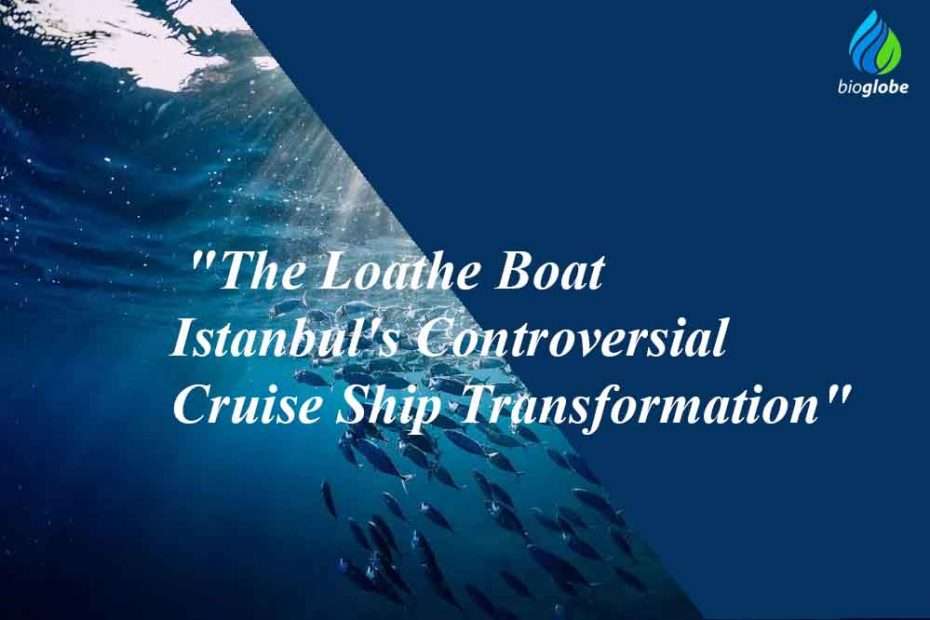“The Loathe Boat – Istanbul’s Controversial Cruise Ship Transformation”
Two years after Galataport opened to fanfare as a tourism success story, not everyone is happy about how it has transformed the Turkish coastline
In the bustling city of Istanbul, where history and modernity converge, a controversy is brewing. Two years after the grand opening of Galataport, a project that was hailed as a tourism success story, not everyone is pleased with how it has transformed the Turkish coastline. Dubbed by some as “The Loathe Boat,” these mammoth cruise ships have become a source of contention for the locals living near the bustling Istanbul port.
Even if you don’t see them on the horizon, you can’t escape the cacophony they create. The arrival times of these cruise ships have become an essential part of daily life for some Istanbul residents, allowing them to plan their outings to avoid the visual onslaught. But the one thing they can’t escape is the deafening noise—a booming horn that echoes over the surrounding hills. In an ironic twist, some cruise ships even play the theme from the television show “The Love Boat” as they make their grand entrance into the port.
“They’re huge,” says Ali, a waiter at a municipal cafe that boasts a prime view of Galataport. “It completely obscures the view when they arrive.”
This cafe has become a popular spot due to its picturesque location overlooking the Golden Horn and the Bosphorus. On clear days, patrons can gaze all the way to the historic Maiden’s Tower. However, the tranquility of this scene is often disrupted by the arrival of up to three massive cruise ships at once. Some of these ships are so colossal that their arrival makes headlines, like the Splendida, with a capacity of 4,000 passengers, that docked in late May. Navigating through the busy waters of the Bosphorus, these cruise ships must cross paths with ferries and even tankers to reach their designated berths.
For some locals, these cruise ships are a constant reminder of how a prime stretch of Istanbul’s coastline has been privatized. When Galataport opened its doors two years ago, it marked the transformation of approximately 1 kilometer of coast. What was once a collection of warehouses, an aging post office, and a ferry terminal from the 1940s had been turned into a manicured, shiny dockside complex featuring high-end restaurants, a luxury hotel, upscale watch and perfume shops, and an outdoor mall. This ambitious €1.5 billion project was lauded as a significant tourism and investment success by the government of Recep Tayyip Erdoğan. In 2021, Erdoğan proudly declared it a “worldwide project with the potential of drawing 25 million visitors, 7 million tourists, and 1.5 million cruise passengers.”
Yet, the Galataport project faced fierce opposition long before its construction began. Opponents cited a clause in Turkey’s constitution emphasizing that “public interest shall be taken into consideration with priority” regarding coastal developments. Despite this, authorities rezoned the area for tourism, allowing the project to proceed. The Union of Chambers of Turkish Engineers and Architects (TMMOB) fought against local authorities in court for nearly two decades, citing environmental concerns and the social fabric’s disruption.
Supporters of Galataport argue that it has brought financial benefits to Istanbul by creating jobs, attracting wealthy Mediterranean cruise tourists, and stimulating neighborhood redevelopment. Ferit Şahenk, the chairman of Doğus Holding, a major investor, stated a year before its opening, “This 1.2 km-long coastline had been closed to the public for over 200 years. Now, we are opening it.”
However, critics are quick to point out that the extensive security measures around Galataport contradict claims of openness. Metal walls separate the cruise ships from the dock, further obstructing the view for those above ground. A complex network of underground passport control booths and passageways ushers cruise ship passengers onto tour buses that transport them to distant city attractions, far from the port.
Nazlı Eğinlioğlu, a resident close to the development, emphasizes how these cruise ships have created a gentrification ripple effect, leading to higher property taxes and soaring rents, especially during the recent economic crisis and the rapid devaluation of Turkey’s currency, the lira. To her, the area now feels like a gated community, disconnected from its surroundings and catering primarily to tourists. As rents soar, apartments are transformed into high-end businesses, selling products and services that are out of reach for many locals.
Eğinlioğlu labels this phenomenon as “ruthless tourism,” where resources are directed toward tourists, leaving locals priced out of their own city. The promise of a more accessible coastline remains elusive.
Despite the criticisms and discontent among the locals, the Galataport project has gained favor with Erdoğan’s government to such an extent that even the administration in Istanbul, led by the main opposition party, is contemplating a similar development. The Haliçport redevelopment plan, further up the Golden Horn, aims to transform a historic industrial port into a sprawling mall and luxury hotel complex, complete with a marina designed for yachts. While construction is still in its early stages, it is already generating criticism for the demolition of historic buildings.
For Istanbul residents like Elif Refiğ, who has lived near the port for nearly two decades, the cruise ships that grace her balcony view and the nightly music blaring from their decks serve as constant reminders of how the port’s development has reshaped the neighborhood.
“In the end,” she reflects, “the cruise ships are not the major problem but just the latest extension of one.”


